 Today I have received a copy of the fourth volume of the Audiovisual Course on New Technologies in Urology. A training programme sponsored by Pfizer and supported by the Spanish Urological Association. I already contributed for volume I with a video and a chapter on PVP - Photoselective Vaporization of the Prostate. In this volume IV I have published an article and a video on Cryosurgical ablation of prostate cancer. This is an interesting video, it includes images of the 4D transrectal ultrasound monitorization of the procedure, a new approach we performed at the Instituto de Cirugía Urológica Avanzada (ICUA), in Madrid.
Today I have received a copy of the fourth volume of the Audiovisual Course on New Technologies in Urology. A training programme sponsored by Pfizer and supported by the Spanish Urological Association. I already contributed for volume I with a video and a chapter on PVP - Photoselective Vaporization of the Prostate. In this volume IV I have published an article and a video on Cryosurgical ablation of prostate cancer. This is an interesting video, it includes images of the 4D transrectal ultrasound monitorization of the procedure, a new approach we performed at the Instituto de Cirugía Urológica Avanzada (ICUA), in Madrid.
This training course will be provided for free to all Spanish urologists. The editor is one of my colleagues at the ICUA, Dr. Ignacio Castillón. He was trained as a laparoscopist in L.A., USA. 90% of the content in this audiovisual course is related to laparoscopy. 
Thursday, December 22, 2005
Audiovisual Course on New Technologies in Urology
Published by
Fernando Gómez Sancha
on
7:29 PM
0
comments
![]()
Monday, December 19, 2005
New training session in La Coruña
 This Monday, December 19th, I went to La Coruña again to participate in a Photoselective vaporization of the prostate (PVP) surgical training session. We did two operations, the morning session on a patient with a 70 gram prostate and the afternoon session on a patient with a 90 gram prostate. The day was uneventful, we had time to go a wonderful restaurant for lunch, with a view of La Coruña. Octopus is the local specialty and it is delicious. I then came back to Madrid, the following day I had to operate a friend who is a Doctor and his prostate volume was 105 cc. The operation was also uneventful and I was able to discharge him in the afternoon, after two and a half hours of PVP. The more PVPs I do, the more I like PVP, recovery is so spectacular, patients go back to their normal lifes, and results are so good!!!
This Monday, December 19th, I went to La Coruña again to participate in a Photoselective vaporization of the prostate (PVP) surgical training session. We did two operations, the morning session on a patient with a 70 gram prostate and the afternoon session on a patient with a 90 gram prostate. The day was uneventful, we had time to go a wonderful restaurant for lunch, with a view of La Coruña. Octopus is the local specialty and it is delicious. I then came back to Madrid, the following day I had to operate a friend who is a Doctor and his prostate volume was 105 cc. The operation was also uneventful and I was able to discharge him in the afternoon, after two and a half hours of PVP. The more PVPs I do, the more I like PVP, recovery is so spectacular, patients go back to their normal lifes, and results are so good!!!
Published by
Fernando Gómez Sancha
on
11:54 PM
0
comments
![]()
Tuesday, December 13, 2005
New training session in Barcelona
 Today I went to Barcelona, to participate in another surgical teaching session at TEKNON hospital, in Barcelona. We did two PVP cases, both prostates were relatively small, so the surgeries did not take much, and everything developed smoothly. One of the patients had been operated in the past, fifteen years ago, with a TUIP (Transurethral incision of the prostate), performed with a classic resectoscope. His prostate was highly irregular, but this did not pose any problem. We did not see a drop of blod in all day, both cases were highly satisfactory.
Today I went to Barcelona, to participate in another surgical teaching session at TEKNON hospital, in Barcelona. We did two PVP cases, both prostates were relatively small, so the surgeries did not take much, and everything developed smoothly. One of the patients had been operated in the past, fifteen years ago, with a TUIP (Transurethral incision of the prostate), performed with a classic resectoscope. His prostate was highly irregular, but this did not pose any problem. We did not see a drop of blod in all day, both cases were highly satisfactory.
Published by
Fernando Gómez Sancha
on
9:06 PM
0
comments
![]()
Monday, December 12, 2005
New training session in La Coruña
 Today I took a plane to La Coruña, to participate in another teaching session. The case we operated today was relatively difficult. The prostatic size was not too big, but it was richly vascularised and had a tendency to bleed. As the instrument we introduce through the urethra for Photoselective Vaporization of the Prostate is rather thin, and the irrigation of water in-and- out the bladder it provides is rather slow, any amount of blood, no matter how small, obscures vision and makes the procedure more difficult. We had to use all the surgical tricks and strategies to be able to finish the procedure successfully. A teaching session with a high learning value. The image shows the Veru Montanum, the anatomic structure where ejaculatory ducts drain into the urethra. This is an important surgical landmark, because it tells the surgeon the exact localization of the external urinary sphincter, that must be respected. A little bit upwards, both lateral lobes can be seen in part, they obstruct urinary flow in the same way as tonsils obstruct the pharynx in children...
Today I took a plane to La Coruña, to participate in another teaching session. The case we operated today was relatively difficult. The prostatic size was not too big, but it was richly vascularised and had a tendency to bleed. As the instrument we introduce through the urethra for Photoselective Vaporization of the Prostate is rather thin, and the irrigation of water in-and- out the bladder it provides is rather slow, any amount of blood, no matter how small, obscures vision and makes the procedure more difficult. We had to use all the surgical tricks and strategies to be able to finish the procedure successfully. A teaching session with a high learning value. The image shows the Veru Montanum, the anatomic structure where ejaculatory ducts drain into the urethra. This is an important surgical landmark, because it tells the surgeon the exact localization of the external urinary sphincter, that must be respected. A little bit upwards, both lateral lobes can be seen in part, they obstruct urinary flow in the same way as tonsils obstruct the pharynx in children...
Published by
Fernando Gómez Sancha
on
8:44 PM
0
comments
![]()
Saturday, December 10, 2005
Meeting of Spanish Greenlight users at USP Hospital San José
 This saturday we celebrated the second meeting of the Spanish users of the Greenlight Laser at thel Hospital USP San José de Madrid, the institution where I work. The meeting was kindly sponsored by Davanzia, the medical company that distributes this KTP laser and other medical products in Spain. The meeting was organized with the help of USP and the Instituto de Cirugía Urológica Avanzada. We welcomed doctors working in 20 out of the 25 (soon 30) units offering this technique throughout the country. Two live surgeries were performed, one in a 100 gram prostate, by Drs. Torrecillas, Macías and myself, to show the different strategies and techniques used. This was transmitted via a videolink to the audience. In the afternoon, I performed a PVP on a patient with a 166 gram prostate. It was interesting to share the initial experience of the groups offering this relatively new technique in the country. It allowed us to share experiences and technical aspects of great interest, specially for those groups with less experience. All presentations were of high quality and I believe all participants went back home with better knowledge on the technique and convinced about the fact that PVP will gradually substitute TURP for its high efficacy and low morbidity.
This saturday we celebrated the second meeting of the Spanish users of the Greenlight Laser at thel Hospital USP San José de Madrid, the institution where I work. The meeting was kindly sponsored by Davanzia, the medical company that distributes this KTP laser and other medical products in Spain. The meeting was organized with the help of USP and the Instituto de Cirugía Urológica Avanzada. We welcomed doctors working in 20 out of the 25 (soon 30) units offering this technique throughout the country. Two live surgeries were performed, one in a 100 gram prostate, by Drs. Torrecillas, Macías and myself, to show the different strategies and techniques used. This was transmitted via a videolink to the audience. In the afternoon, I performed a PVP on a patient with a 166 gram prostate. It was interesting to share the initial experience of the groups offering this relatively new technique in the country. It allowed us to share experiences and technical aspects of great interest, specially for those groups with less experience. All presentations were of high quality and I believe all participants went back home with better knowledge on the technique and convinced about the fact that PVP will gradually substitute TURP for its high efficacy and low morbidity.
Published by
Fernando Gómez Sancha
on
11:00 PM
1 comments
![]()
Friday, December 02, 2005
Invitation to operate in Chile 4
Today we returned to the theatres of the Military Hospital in Santiago de Chile to carry out the last surgical training session. It has been a privilege to get to know this urology department where all urologists are great specialists and also fantastic human beings. We have again operated three patients and I will return to spain with the nice feeling that the urologists of this department have taken advantage of the training and are now able to carry out a PVP (Photoselective Vaporization of the Prostate) correctly and in a safe and efficacious way. Two o fthe patients we operated yesterday voided without problems, the last one had some difficulty and we decided to keep a small urinary catheter for a couple of days. The surgical result was very good, so he will do well for sure. All patients had clear urine and felt very well. Coming to Chile has been a very enriching experience and it has been a privilege to be able to share some time with the urologists from the Military Hospital. The head of the department of urology, Dr. Fernando Coz is a fantastic urologist and a wonderful person. This morning he was able to operate one of the patients with technical perfection. After the satisfaction of having contributed to this department and their future patients, I will take some time to rest visiting the south of Chile with my wife.
Coming to Chile has been a very enriching experience and it has been a privilege to be able to share some time with the urologists from the Military Hospital. The head of the department of urology, Dr. Fernando Coz is a fantastic urologist and a wonderful person. This morning he was able to operate one of the patients with technical perfection. After the satisfaction of having contributed to this department and their future patients, I will take some time to rest visiting the south of Chile with my wife.
Published by
Fernando Gómez Sancha
on
3:32 AM
0
comments
![]()
Thursday, December 01, 2005
Invitation to operate in Chile 3
 Today we performed three new cases of PVP (Photoselective vaporization of the prostate) at the Military Hospital at Santiago de Chile. We did two simple cases with prostatic weights of 40 and 50 grams and a more difficult one, with 79 grams, that was very successful and I was able to complete it in one hour and fifteen minutes. We visited the patients operted the previous morning, and were catheter-free and voided wonderfully, their flow rate was 12, 14 and 18 mL/s, and it will improve further day by day. The personnel working at the military hospital was very surprised to witness the results of this technique.
Today we performed three new cases of PVP (Photoselective vaporization of the prostate) at the Military Hospital at Santiago de Chile. We did two simple cases with prostatic weights of 40 and 50 grams and a more difficult one, with 79 grams, that was very successful and I was able to complete it in one hour and fifteen minutes. We visited the patients operted the previous morning, and were catheter-free and voided wonderfully, their flow rate was 12, 14 and 18 mL/s, and it will improve further day by day. The personnel working at the military hospital was very surprised to witness the results of this technique. The Military Hospital in Santiago is very nice and it looks as a wonderful hospital, but they are building a new one and they will move there next year. The theatre's personell is really nice and efficient. The urologists working here have enjoyed this experience because they thought this technique was something different. They thought PVP was a slow and less spectacular than it really is. I have taught them all the tricks I know to perform it safely and efficaciously.
The Military Hospital in Santiago is very nice and it looks as a wonderful hospital, but they are building a new one and they will move there next year. The theatre's personell is really nice and efficient. The urologists working here have enjoyed this experience because they thought this technique was something different. They thought PVP was a slow and less spectacular than it really is. I have taught them all the tricks I know to perform it safely and efficaciously.
During the afternoon, I dictated the conference "PVP (Photoselective vaporization of the prostate, a new horizon in the treatment of BPH" in the auditorium at the Military Hospital. After my presentation we had a discussion that was very fruitful, with very good questions from the floor related to the technique.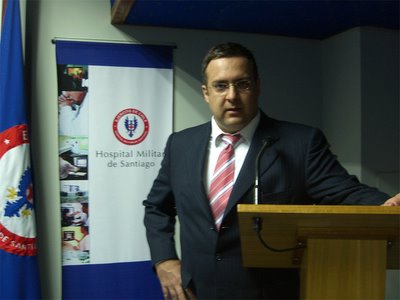
Published by
Fernando Gómez Sancha
on
11:30 AM
0
comments
![]()
Tuesday, November 29, 2005
Invitation to operate in Chile 2
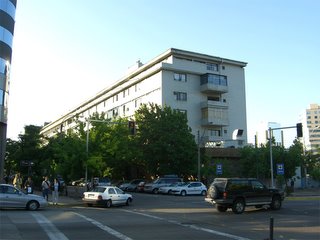 Today we had the fist surgical session, with Dr. Fernando Coz, head of the department of Urology of the Military Hospital in Santiago de Chile. We have operated three patients with relatively small prostates (40-55 grams), so the session was uneventful. It was a very fruitful session, all the attendants learned the physical bases of laser-tissue interaction and we have reviewed all the tips and tricks that make PVP (Photoselective Vaporization of the prostate) a safe and efficient operation. Tomorrow we will perform three more surgeries and then I will dictate the conference I announced in the previous post of this blog.
Today we had the fist surgical session, with Dr. Fernando Coz, head of the department of Urology of the Military Hospital in Santiago de Chile. We have operated three patients with relatively small prostates (40-55 grams), so the session was uneventful. It was a very fruitful session, all the attendants learned the physical bases of laser-tissue interaction and we have reviewed all the tips and tricks that make PVP (Photoselective Vaporization of the prostate) a safe and efficient operation. Tomorrow we will perform three more surgeries and then I will dictate the conference I announced in the previous post of this blog.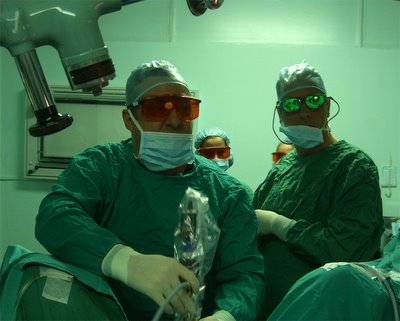
Published by
Fernando Gómez Sancha
on
8:51 PM
0
comments
![]()
Sunday, November 27, 2005
Training and conference in Chile
 Today I travel to Santiago de Chile. I have been invited to train the urologists of the Military Hospital of Santiago de Chile on PVP (Photoselective Vaporization of the Prostate). We will operate three patients per day during three days, November 29th and 30th and December 1st. The 30th I will also dictate a conference at the Military Hospital, organised by the Chilenian Urology Society.
Today I travel to Santiago de Chile. I have been invited to train the urologists of the Military Hospital of Santiago de Chile on PVP (Photoselective Vaporization of the Prostate). We will operate three patients per day during three days, November 29th and 30th and December 1st. The 30th I will also dictate a conference at the Military Hospital, organised by the Chilenian Urology Society.
Published by
Fernando Gómez Sancha
on
11:51 AM
0
comments
![]()
Friday, November 25, 2005
Training Marathon in Bilbao
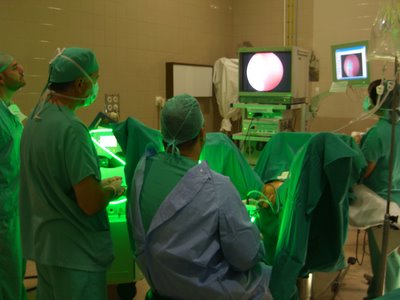 I spent the whole day in Bilbao training a group of urologists on PVP (Photoselective Vaporization of the Prostate). We operated four patients, the first one had a 120 gram prostate and the rest had prostates weighting 40, 60 and 70 grams. We stopped for lunch and I had the chance to enjoy again the vasc cuisine, always a wonderful experience. These surgical sessions are quite intensive but the learning value is very high. The bad part of it is taking the return flight, it is always late, and when it arrives to Madrid they take it to the parking lot which is usually very far away from the terminal..... I arrived at home at 12.00 pm and fell into bed. Tomorrow I have to operate in Madrid and I will travel to Chile this sunday.
I spent the whole day in Bilbao training a group of urologists on PVP (Photoselective Vaporization of the Prostate). We operated four patients, the first one had a 120 gram prostate and the rest had prostates weighting 40, 60 and 70 grams. We stopped for lunch and I had the chance to enjoy again the vasc cuisine, always a wonderful experience. These surgical sessions are quite intensive but the learning value is very high. The bad part of it is taking the return flight, it is always late, and when it arrives to Madrid they take it to the parking lot which is usually very far away from the terminal..... I arrived at home at 12.00 pm and fell into bed. Tomorrow I have to operate in Madrid and I will travel to Chile this sunday.
Published by
Fernando Gómez Sancha
on
9:29 AM
0
comments
![]()
Wednesday, November 23, 2005
New surgical Session in Valencia
 After operating a urethral stricture in the Hospital de La Princesa in Madrid, I took a plane to Valencia, where we conducted a training session on PVP (Photoselective Vaporization of the prostate) for Benign Prostatic Hyperplasia. I trained four local urologists. We performed two interventions, a 40 gram prostate and an 80 gram prostate, that progressed smoothly. I then came back to Madrid by plane, tomorrow I have to operate more cases of PVP at my hospital, Hospital USP San José, in Madrid.
After operating a urethral stricture in the Hospital de La Princesa in Madrid, I took a plane to Valencia, where we conducted a training session on PVP (Photoselective Vaporization of the prostate) for Benign Prostatic Hyperplasia. I trained four local urologists. We performed two interventions, a 40 gram prostate and an 80 gram prostate, that progressed smoothly. I then came back to Madrid by plane, tomorrow I have to operate more cases of PVP at my hospital, Hospital USP San José, in Madrid.
Published by
Fernando Gómez Sancha
on
9:56 PM
0
comments
![]()
Urethral surgery masterclass
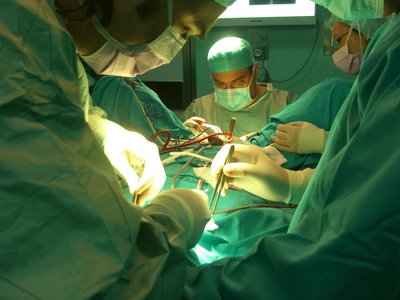
 Today I have operated a very complex case of urethral stenosis at the Hospital de la Princesa in Madrid. As I commented in this blog before, I am invited to this hospital whenever there is a urethral stenosis case. This patient had a very long bulbar urethal stenosis. We have managed to reconstruct this with a double buccal mucosa free graft in a dorsal position. In this image, we have worked in two teams. I prepared the urethra and two surgeons took the grafts from the inside aspect of the cheek. I have had to rush off to the airport, as I had to operate in Valencia the same afternoon.
Today I have operated a very complex case of urethral stenosis at the Hospital de la Princesa in Madrid. As I commented in this blog before, I am invited to this hospital whenever there is a urethral stenosis case. This patient had a very long bulbar urethal stenosis. We have managed to reconstruct this with a double buccal mucosa free graft in a dorsal position. In this image, we have worked in two teams. I prepared the urethra and two surgeons took the grafts from the inside aspect of the cheek. I have had to rush off to the airport, as I had to operate in Valencia the same afternoon.
The surgery today was a success.
Published by
Fernando Gómez Sancha
on
9:34 PM
0
comments
![]()
Tuesday, November 22, 2005
Invitation to perform a live surgery


Today I received a letter inviting me to perform a live surgery, a PVP (Photoselective vaporization of the prostate) during the 11th International Congress that will take place in Zaragoza.
Published by
Fernando Gómez Sancha
on
10:40 AM
0
comments
![]()
Wednesday, November 16, 2005
Urolap 2005
 Today I will attend the International Course on Laparoscopy - Urolap 2005, organised by La Paz Hospital. It is probably one of the best courses in the world in laparoscopy, due to the quality of its organization, the quality of the live surgeries and because all the current world experts are here. I have attended as a student, I did not want to miss it. During this course I have contacted Dr. Gastón, one of the three or four best laparoscopic urologists in the world, and he has accepted to come to Madrid for a teaching session in our surgical theatre. He will operate a patient in January in collaboration with Dr. Castillón, the head of the Laparoscopy unit at the Instituto de Cirugía Urológica Avanzada.
Today I will attend the International Course on Laparoscopy - Urolap 2005, organised by La Paz Hospital. It is probably one of the best courses in the world in laparoscopy, due to the quality of its organization, the quality of the live surgeries and because all the current world experts are here. I have attended as a student, I did not want to miss it. During this course I have contacted Dr. Gastón, one of the three or four best laparoscopic urologists in the world, and he has accepted to come to Madrid for a teaching session in our surgical theatre. He will operate a patient in January in collaboration with Dr. Castillón, the head of the Laparoscopy unit at the Instituto de Cirugía Urológica Avanzada.
Published by
Fernando Gómez Sancha
on
10:26 AM
0
comments
![]()
Monday, November 14, 2005
New surgical session in La Coruña
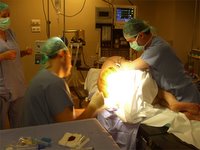 Today I travelled to the northwest of Spain, to La Coruña, to participate in a very difficult case. A patient with a prostate larger than 150 grams. I could not see any ultrasound of the patient before surgery, but his digital rectal examination revealed the pressence of a massive prostate. Endoscopically it was also huge, and very long (7 cm). Maybe the biggest case I have done (I operated a 200 gram prostate once, but it was easier to operate).
Today I travelled to the northwest of Spain, to La Coruña, to participate in a very difficult case. A patient with a prostate larger than 150 grams. I could not see any ultrasound of the patient before surgery, but his digital rectal examination revealed the pressence of a massive prostate. Endoscopically it was also huge, and very long (7 cm). Maybe the biggest case I have done (I operated a 200 gram prostate once, but it was easier to operate).
We finally managed to complete the operation without much trouble, I think the patient will do very well. We spent more than 3 hours in theatre, it gets long and one gets tired, but the result is very satisfactory. In cases like this the usual spinal anaesthetic is not enough, so the anaesthetist must perform a combined anaesthetic spinal + epidural, that allows for new bolus of local anaesthetic to be administered if the surgery is prolongued. This way patients are confortable during the procedure.
Then I returned to Madrid, I will operate three cases in Hospital USP San José. Two of them are high risk patients, one is very bothered with his bladder and the second one has been catheterised for months, he was not considered fit enough for surgery and his doctors told him he had to live with a catheter forever. Maybe the KTP laser prostatectomy will be their only chance to recover a normal life. (update November 16th.... all three cases went fine, all patients are happy and back home already).
Published by
Fernando Gómez Sancha
on
12:05 AM
0
comments
![]()
Sunday, November 13, 2005
Basic Laparoscopy Course in Madrid


Yesterday I participated as invited teacher at the Basic Laparoscopic Urology Course organised by Dr. Ignacio Castillón (upper photo), director of the Escuela Europea de Laparoscopia Urológica (European School of Laparoscopic Urology) in collaboration with the Instituto de Cirugía Urológica Avanzada (Institute of Advanced Urological Surgery).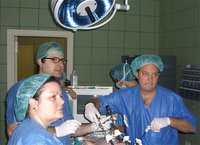 The objective was to initiate in laparoscopy techniques to a group of eight urologists. Nowadays laparoscopic (keyhole) surgery is taking over open surgery and has important advantages for patients. Urologists have to learn these techniques in courses like this and aquire the surgical skills before they can apply these techniques to the treatment of their patients.
The objective was to initiate in laparoscopy techniques to a group of eight urologists. Nowadays laparoscopic (keyhole) surgery is taking over open surgery and has important advantages for patients. Urologists have to learn these techniques in courses like this and aquire the surgical skills before they can apply these techniques to the treatment of their patients.  .
.
The course took place in four different surgical theatres, perfectly equipped thanks to the generosity of Olympus and other sponsoring companies that provided laparoscopy surgical instruments.  This initiative would have not been possible without the collaboration of the Hospital Clínico Veterinario, an ideal place for this kind of courses. The presence of other very experienced urologists as Dr. Estébanez, laparoscopist from San Sebastián, and Dr. Páez, head of the department of urology of the NHS Hospital of Fuenlabrada in Madrid, helped to ensure that the quality of the training was superb. The participants in the course thought the course was "excellent", as it showed in the evaluation forms we provided them at the end of the course. The Escuela Europea de Laparoscopia Urológica (European School of Laparoscopic Urology) organises basic laparoscopy courses and also more specialised courses as the one in Advanced Renal Surgery that will take place in February. Urologists interested in these courses can contact the school coordinator, Ana María Muñoz, her telephone number is +34914352844.
This initiative would have not been possible without the collaboration of the Hospital Clínico Veterinario, an ideal place for this kind of courses. The presence of other very experienced urologists as Dr. Estébanez, laparoscopist from San Sebastián, and Dr. Páez, head of the department of urology of the NHS Hospital of Fuenlabrada in Madrid, helped to ensure that the quality of the training was superb. The participants in the course thought the course was "excellent", as it showed in the evaluation forms we provided them at the end of the course. The Escuela Europea de Laparoscopia Urológica (European School of Laparoscopic Urology) organises basic laparoscopy courses and also more specialised courses as the one in Advanced Renal Surgery that will take place in February. Urologists interested in these courses can contact the school coordinator, Ana María Muñoz, her telephone number is +34914352844.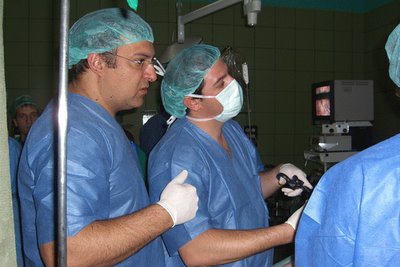
Published by
Fernando Gómez Sancha
on
10:42 AM
0
comments
![]()
Friday, November 11, 2005
PVP workshop in Santiago de Compostela
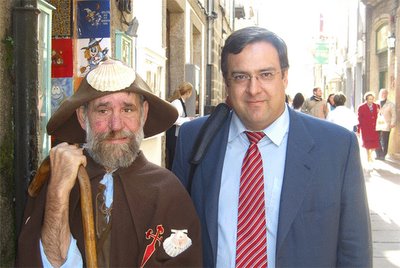 Today I left Madrid early in the morning towards Santiago de Compostela. This time I have had a little free time and managed to walk around the "plaza del Obradoiro", in front of the Cathedral of Santiago. It is a beauty. This is how the pilgrims look like when they reach Santiago by foot from France. I have then gone to eat some octopus in a local restaurant.
Today I left Madrid early in the morning towards Santiago de Compostela. This time I have had a little free time and managed to walk around the "plaza del Obradoiro", in front of the Cathedral of Santiago. It is a beauty. This is how the pilgrims look like when they reach Santiago by foot from France. I have then gone to eat some octopus in a local restaurant.
At three pm I went walking to the hospital where I had to train two urologists in the technique of Photoselective Vaporization of the prostate.
We did two operations, one of the prostates was relatively big, weighing 75 grams. The second one was smaller, ideal for training. I had to rush to the airport thinking that I was late, but after boarding we had to disembark due to an aeroplane's motor breakdown. I am updating this blog from the airport and I do not know yet if I will have to sleep in Santiago or if I will be able to get home tonight. Tomorrow I have to participate as a teacher in the Basic Laparoscopy course organised by Dr. Castillón. An initiative of the European School of Urologic Laparoscopy in collaboration with the Institute of Advanced Urological Surgery, our institution.


Published by
Fernando Gómez Sancha
on
10:41 PM
0
comments
![]()
Invitation to operate in Vienna
 Yesterday I received an invitation to train the prostate specialists of the Urology Department of the University Hospital in Vienna. The head of the department is Prof. Marberger, one of the "fathers" of European Urology. Dr. Djavan is also an eminent urologist well known for his contributions to Benign Prostatic Hyperplasia. Dr. Marberger and I met recently at the International Urology Congress celebrated in Madrid. I think he was convinced by the efficacy and simplicity of Photoselective Vaporization of the Prostate. Apparently they have decided to adopt this technique and I am invited to a two day workshop in which I will lecture on the basic aspects of this technique and we will perform several surgeries. I will keep you posted in this blog.
Yesterday I received an invitation to train the prostate specialists of the Urology Department of the University Hospital in Vienna. The head of the department is Prof. Marberger, one of the "fathers" of European Urology. Dr. Djavan is also an eminent urologist well known for his contributions to Benign Prostatic Hyperplasia. Dr. Marberger and I met recently at the International Urology Congress celebrated in Madrid. I think he was convinced by the efficacy and simplicity of Photoselective Vaporization of the Prostate. Apparently they have decided to adopt this technique and I am invited to a two day workshop in which I will lecture on the basic aspects of this technique and we will perform several surgeries. I will keep you posted in this blog.
Published by
Fernando Gómez Sancha
on
1:18 PM
0
comments
![]()
Thursday, November 10, 2005
Training seminar in Valencia
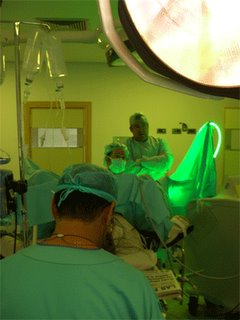 Today I jumped to valencia to participate in a training seminar. We performed a case of Benign Prostatic Hyperplasia with a high power (80 W) KTP laser, under spinal anaesthetic. I returned to Madrid the same day. This was a high risk patient that we managed to operate without losing a single drop of blood. It was a very satisfactory operation. As this photograph demonstrates, in this operation the patient is so safe that the anaesthetist only performs the spinal anaesthesia and then he can read the newspaper.
Today I jumped to valencia to participate in a training seminar. We performed a case of Benign Prostatic Hyperplasia with a high power (80 W) KTP laser, under spinal anaesthetic. I returned to Madrid the same day. This was a high risk patient that we managed to operate without losing a single drop of blood. It was a very satisfactory operation. As this photograph demonstrates, in this operation the patient is so safe that the anaesthetist only performs the spinal anaesthesia and then he can read the newspaper.
Published by
Fernando Gómez Sancha
on
10:57 PM
0
comments
![]()
Sunday, November 06, 2005
USP Interhospitalary Meeting on Urology
This weekend we have celebrated the USP interhospitalary meeting on urology. This is the first meeting gathering all urologists working at USP hospitals in Spain. The objective is to allow each urology department to present the new advances, as well as to establish a closer contact among the urologists working for this group of private hospitals, so that we can offer a better service to our patients. All presentations were excellent and all participants had put a lot of interest in this meeting. I really enjoyed during this meeting.
I have presented my experience with PVP (KTP laser photoselective vaporization of the prostate). I also presented a video where we performed a partial laparoscopic nephrectomy using a low power KTP laser. This is a possible future application of this laser we are investigating at the Hospital Clínico Veterinario, in Madrid.

Published by
Fernando Gómez Sancha
on
9:08 AM
0
comments
![]()
Thursday, November 03, 2005
New training session in Valencia
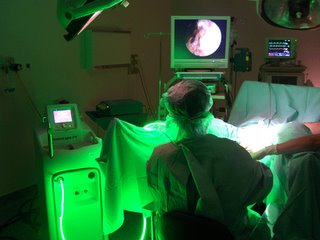 Today I operated in Madrid in the morning. I had a relatively young patient with a big prostate (120 grams). He had suffered several episodes of urinary retention and had to carry a urinary catheter. He wanted to avoid open surgery and its risks (including impotence, incontinence and so on).
Today I operated in Madrid in the morning. I had a relatively young patient with a big prostate (120 grams). He had suffered several episodes of urinary retention and had to carry a urinary catheter. He wanted to avoid open surgery and its risks (including impotence, incontinence and so on).
I then travelled to Valencia to participate in a new training session. We operated a patient with a big prostate similar to the one I did this morning.
Then I went back to Madrid and visited the patient I operated this morning. He had managed to void and was happy without his catheter.
Published by
Fernando Gómez Sancha
on
11:12 PM
0
comments
![]()
Tuesday, November 01, 2005
Training session in Valencia
Today I travelled to Valencia to participate in a training session. We had a very complex patient, with a huge 130 gram prostate. These big prostates can be operated, but they require a longer operating time and patience. This operation took 3 hours and we applied 750.000 joules. The prostate had an enormous median lobe that occupied the prostatic urethra and protruded inside the bladder. We managed to vaporize it and to leave a huge prostatic cavity. It was a very interesting case, big prostates are always a challenge but this one was special for its peculiar anatomy. Some urologists think that median lobes are difficult to treat with the KTP laser, but it is rather easy to vaporize them completely, you only need to know some simple tricks.
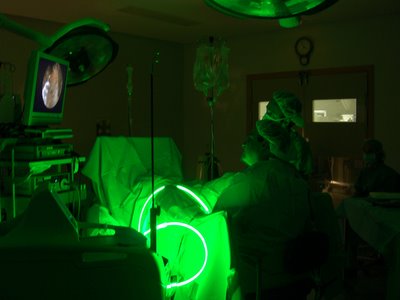
 We also realised that irrigation can be improved with a suprapubic 5 mm laparoscopy trocar. I did not carry with me the Reuter trocar I use in these difficult cases (it is getting more difficult to get it into an aeroplane - it is a sharp metallic object). So this was a good idea, nowadays all hospitals have laparoscopy trocars. This enhances irrigation, the vision gets very clear and it is very useful to operate big prostates with a very small risk and good results. The patient gets a 5 mm wound in his lower abdomen, that is not much of a problem at all. I took the plane back to Madrid, we have a Bank Holiday and tomorrow I will get a chance to rest for a while. I have to return to Valencia this thursday to participate in another rather difficult case.
We also realised that irrigation can be improved with a suprapubic 5 mm laparoscopy trocar. I did not carry with me the Reuter trocar I use in these difficult cases (it is getting more difficult to get it into an aeroplane - it is a sharp metallic object). So this was a good idea, nowadays all hospitals have laparoscopy trocars. This enhances irrigation, the vision gets very clear and it is very useful to operate big prostates with a very small risk and good results. The patient gets a 5 mm wound in his lower abdomen, that is not much of a problem at all. I took the plane back to Madrid, we have a Bank Holiday and tomorrow I will get a chance to rest for a while. I have to return to Valencia this thursday to participate in another rather difficult case.
Published by
Fernando Gómez Sancha
on
1:11 AM
0
comments
![]()
Friday, October 28, 2005
Training session in Barcelona
Today I returned to Barcelona to participate in a training session on Photoselective Vaporization of the Prostate (PVP) for Benign prostatic Hyperplasia. We just did one case and it was rather quick because the prostate was small. Next Tuesday we have a bank holiday in Spain, so everybody was rushing out the big cities, Barcelona and Madrid, there was heavy rain too, so the airports were colapsed. I have waited for hours at the airport in Barcelona and I got very late to Madrid, I managed to read some papers I use to carry with me, so it was not a completely waste of time. Tomorrow we have another case in Hospital San José, where I usually work, but this time it is a bigger prostate gland, aproximately 90 grams. We took a photo and look what a beautiful shot we got.
Published by
Fernando Gómez Sancha
on
11:17 PM
0
comments
![]()
Wednesday, October 26, 2005
Training Marathon in Valencia
 Today I have travelled to Valencia, to participate in a surgical kind of Marathon at the General Hospital.
Today I have travelled to Valencia, to participate in a surgical kind of Marathon at the General Hospital.
We have operated four patients, two before lunch and other two after lunch. Fortunately, the patient's prostates were relatively small, and this has allowed us to spend a little bit more than an hour in each case.
Three urologists have had their first experience with photoselective vaporization of the prostate, and have tried the technique under my supervision. These urologists are already experienced endoscopic surgeons, and for them the learning process consists in adapting to a new surgical tool and different physical principles and technical details, but the truth is that they are operating in a familiar environment (most experienced urologists have operated hundreds or thousands of prostates with the traditional technique, transurethral resection of the prostate - TURP). One should start operating small prostates, it is definitely the way to learn. Things are not so simple as prostatic size increases and it is not advisable to try to operate a big prostate without previous experience with small ones.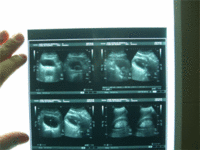
All surgeries have developed smoothly, even when patients were rather old and one of them was terribly frail. He wanted to get rid of his urinary catheter and was happy to learn that there was a safe option for him. Nobody wanted to operate him in his state with the classic technique, due to the high surgical risk.
During these training seminars, once the surgeon learning the technique has had his go, I usually take over and finish the case, to make sure the patient will do well. This is the right way to learn new surgical procedures, because the patient should not have to suffer the learning curve of the surgeon. It would be very rare to experience a serious complication with this operation in the hands of a relatively inexperienced surgeon, but maybe the result of the operation would not be as espectacular if the surgery is not performed correctly.
Photoselective vaporization of the prostate (Greenlight PVP) is such a safe operation that patients will go home tomorrow without a catheter. We all finished the day happily and we went back home after a busy day.
Published by
Fernando Gómez Sancha
on
11:35 PM
0
comments
![]()
Tuesday, October 25, 2005
Training seminar in La Coruña
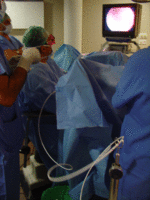
Today I travelled to La Coruña, in the north of Spain, to participate as a surgeon in a workshop on photoselective vaporization of the prostate (PVP). I have operated a patient with a relatively big prostate, 80-90 grams. It was a challenging case, the prostate tended to bleed just by rubbing the cystoscope against the urethral mucosa. He had been catheterised for quite a long time and this caused hyperemia and inflamation. As the irrigation power of the cystoscope I use is rather limited, a minimal amount of blood in the operative field can obscure the endoscopic vision. I decided to use a Reuter suprapubic trocar to improve drainage, and connected the two channels of the scope to the inflow of saline. This allowed me to complete the operation without much trouble. The patient will have a small 5 mm wound in the skin under his umbilicus, It did not even need stitches. I have had to return to Madrid in the latest flight as tomorrow morning I have to perform a prostate cryoablation for prostate cancer at my hospital, USP San José, in Madrid.
Published by
Fernando Gómez Sancha
on
12:44 PM
0
comments
![]()
Friday, October 21, 2005
Round Table - International Congress
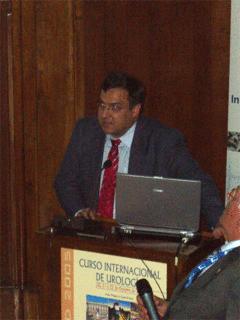 Today we celebrated the round table on new surgical treatment options for benign prostatic hyperplasia (BPH). The moderator was Dr. Vicente and other participants were Marceliano García, Prof. Marberger (Viena, Austria) and Valdivia Uría.
Today we celebrated the round table on new surgical treatment options for benign prostatic hyperplasia (BPH). The moderator was Dr. Vicente and other participants were Marceliano García, Prof. Marberger (Viena, Austria) and Valdivia Uría.
I had five minutes to present the data published up to now on Photoselective Vaporisation of the prostate for BPH and I have included three photographs that have impacted the audience. One photograph depicting the patient I operated yesterday, smiling (I have erased his face to protect his identity), catheter free, ambulant, as if he wasn't operated at all.
I visited him the morning after surgery, and performed a control ultrasound of his prostate and a flow rate measurement. The flow was not very impressive, as not all patients manage to have a very big flow the first day. He had to carry a urinary catheter for months, and in less than 24 hours he got rid of it. The flow will improve day by day. I also took a photograph of the colour of his urine, that I collected in a glass recipient. I had to take these photos with my mobile phone, and then I transferred them to my laptop using the infrared link. So I was able to integrate them into my presentation.
day by day. I also took a photograph of the colour of his urine, that I collected in a glass recipient. I had to take these photos with my mobile phone, and then I transferred them to my laptop using the infrared link. So I was able to integrate them into my presentation.
The public in the room was very suprised to see this quick result. The panelists commented how impresive was the ultrasound image showing a complete removal of hyperplasic tissue. They were also impressed by the smiling patient and the clear urine.
suprised to see this quick result. The panelists commented how impresive was the ultrasound image showing a complete removal of hyperplasic tissue. They were also impressed by the smiling patient and the clear urine.
In the photo below I am with Prof. Marberger and Dr. Valdivia, during the discussion we had after my presentation. Prof. Marberger and I met at the national congress of the Taiwanese Urological Society, celebrated in August 2004, where I presented my experience with the initial 40 patients of my series. 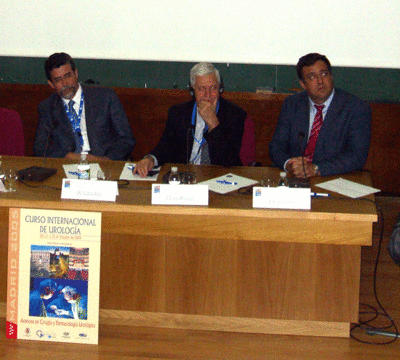
Tomorrow, two doctors from the Institute of Advanced Urological Surgery of Madrid will present their work. Dr. Castillón, director of the laparoscopy unit, as well as Dr. Moncada, director of the Andrology unit, so I will have to wake up early to watch their presentations.
Published by
Fernando Gómez Sancha
on
1:23 PM
0
comments
![]()
Thursday, October 20, 2005
Live surgery - International congress
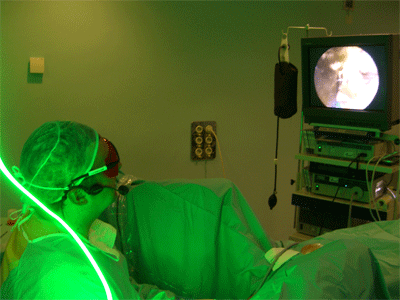 Today was the first day of the International Congress on Advances in Urological Surgery and Pharmacology celebrated in Madrid, Hosted by Prof. Vela Navarrete at the Fundación Jiménez Díaz in Madrid. This is one of the biggest National Health System Hospitals in Madrid. This international congress is celebrated yearly in different venues throughout the country.
Today was the first day of the International Congress on Advances in Urological Surgery and Pharmacology celebrated in Madrid, Hosted by Prof. Vela Navarrete at the Fundación Jiménez Díaz in Madrid. This is one of the biggest National Health System Hospitals in Madrid. This international congress is celebrated yearly in different venues throughout the country. My role in this congress was to perform a live surgery. I have operated a patient with Benign Prostatic Hyperplasia (BPH) and a relatively large prostate (80 gram). The surgery was transmitted to the "Aula Magna" at the Hospital, where there were 250 urologists from Spain and many other countries.
My role in this congress was to perform a live surgery. I have operated a patient with Benign Prostatic Hyperplasia (BPH) and a relatively large prostate (80 gram). The surgery was transmitted to the "Aula Magna" at the Hospital, where there were 250 urologists from Spain and many other countries.
Dr. Vela and I had a conversation during the operation that the participants could listen to. We spoke about the advantages of this new high power 80 Watt KTP laser in the treatment of BPH. Dr. Vela mentioned he had had previous experiences with a Neodimium-YAG laser, but the results of this VLAP treatment (Visual Laser Ablation of the Prostate) were not good. He also had experience with a Holmium laser, but he said the procedure of enucleation was too difficult to perform and they abandoned it. The participants were able to see how this new KTP laser achieves the same endoscopic results as the classic TURP (transurethral resection of the prostate), but without the bleeding and the risk of absorption of irrigants nor hiponatremia. The operation was smooth and easy and the patient was sent to his room directly, tonight they will pull out the catheter I placed in the operating theatre and I am sure he will be discharged tomorrow.
The operation was smooth and easy and the patient was sent to his room directly, tonight they will pull out the catheter I placed in the operating theatre and I am sure he will be discharged tomorrow.
Tomorrow I will participate in a round table in the afternoon where the different surgical techniques, classic and new, for the treatment of BPH will be discussed. I will present the data from the latest studies carried out in the USA and Europe, and I will also comment our experience during the last 30 months and more than 300 patients.

In this photograph, I am with Dr. Ignacio Castillón, director of the laparoscopy unit at the ICUA, that is also invited to this congress as a professor in Urological Laparoscopy, he was so nice to come to theatre to give me some support just before the transmission of the surgery began.
This congress was very well organised and all the medical and nursing personel really spent all their best to make this congress a successful one.
Published by
Fernando Gómez Sancha
on
1:44 PM
0
comments
![]()




